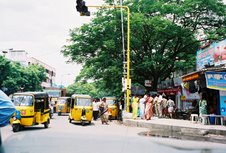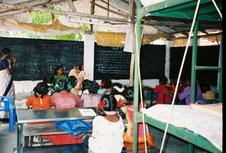
 Tuktuks everywhere
Tuktuks everywhere
It is said that India, with its riotous mix of cultures and landscapes, is not a country for which one can harbor neutral feelings. People either love it or they hate it. I wanted to love it. My idea was a blend of touring and volunteering, but the challenge was doing it within a two-week timetable and on a budget.
It’s true that with a bit of time, it is simple enough to find volunteer work as you travel. If you have money, it is also simple to book a volunteer experience beforehand. I decided that with a decent plan, it could be done without much of either.
The idealist website (see link at the end of the article) gave me a good start. You can search volunteer options based on areas of interest, length of stay and region. I focused on the southern state of Tamil Nadu, where the monsoons come later in the year and where, in the city of Madurai, one can take in the ancient and wondrous Meenakshi Temple.
I struck out with my first contacts. However, the staff at ODAM, Organization for Development, Action, and Maintenance, located in Tiruchuli, listed volunteer openings for periods of time that ranged from one to four months. They were willing to consider my ten-day proposal, if I could outline what I hoped to accomplish. I am an experienced teacher; I offered to compensate for a shortened period of teaching by also writing guidelines for future volunteers. The proposal was accepted and I packed my bags.
I decided to squeeze in some touring on the weekends, while traveling to and from the school. The roads and rails offered a tantalizing feel for the cultural flow of India. In Bangalore, while standing on the train station platform, surrounded by throngs of people waiting for a night train, the sights, smells, and sounds made me feel like I was a character in an exotic novel. I found that if I asked for help, people tried to understand me and pointed me in the right direction. Getting on the correct train at the appointed hour felt like a true travel accomplishment.
As I boarded, I did have that moment of consternation that comes with not knowing how things work, being in everyone’s way. I wore a skirt and realized that the trip to the top bunk was an awkward climb, not designed for those with arthritis, or women in skirts. Once I tossed myself and my stuff on the top bunk, I could watch people passing back and forth without the worry of being a roadblock. One man actually came back to me once the train was underway and apologized because he said he had brushed passed me too hurriedly in the rush to board.
Although the train journeyed through the night hours, I woke early to watch the new landscape pass before our arrival in Madurai. There were expansive flatlands overgrown with brush, reminding me of the dry scrub of Africa. It was not what I imagined this part of India would look like. At the train station, Chantu, the ODAM driver appeared as I was trying to wrest my bags away from an over-zealous taxi man. It seemed that miracles occurred, as needed in this country.
The 35-kilometer car trip to the little town of Tiruchuli and ODAM’s offices, took an hour and a half – mostly due to the congested roads, which appeared to be full of at least one of everything that exists in India. It was fascinating to watch daily life as it ebbed and flowed through the streets. Local pop music poured from the car’s stereo giving me the feeling of being swept up in a warm Indian current.
My time volunteering with ODAM was the learning experience that I had hoped for. The staff helped in many small ways. I was provided with a local cell phone in case I needed help, accompanied to the bus stop so that I found the correct bus, and when I arrived at the main office, the sole computer with an Internet connection was shared readily. The staff at ODAM, from the assistants to the highest level director, made sure I had regular tea, which in this country is an essential comfort. Finally, there were Sunday excursions that allowed me to visit the attractions of Madurai and surrounding towns.
In the village where I was to teach, I met Saroja – Saroja the wonderful, as I came to think of her. She seemed to serve many roles in this community. Saroja’s official title had something to do with the management of food supplies at the school for more than 60 students and staff. However, she excelled at caring for people; including me and most of the girls who studied at the school.
Saroja, her husband Muthuramalingam, and their young son, brought me into their family. I took meals in their home and they taught me how to eat in the way of southern India. It is a bit disconcerting to find oneself a student in eating, but in my experience, food was central to Indian hospitality. I learned to eat my dosa and sambar with my right hand, and to eat the foods in the correct order to strengthen the taste. More importantly, I learned to actually concentrate on eating and not a hundred other things during my meals. And, I did eat heartily in an effort to please my new friends.
In return for being taken into this community, I taught four classes a day to the girls, ages 8-14, who studied and lived at the school. For these students, the invitation to study meant that they did not have to work in area factories. ODAM and its leader, Jeyaraj G., are highly respected for the support they give to the people of the surrounding communities. The goal of ODAM is to establish “equality among human society irrespective of caste, creed, gender, region, religion or language".
The schools are only one way in which ODAM works toward its goals. The organization provides micro-development loans to help women establish their own businesses. ODAM staff has developed a bio-diesel plant to produce an alternative clean fuel. In addition, they maintain the nursery of Jatropha trees whose inedible nuts are utilized in the production of the fuel. All of these projects offer the volunteer a variety of ways to donate their time.

 At work
At work
My time in rural India was not without its trials. The cultural patterns of communication would require much more time to understand. However, what I did learn there certainly felt worth the effort. In this place people face daily challenges dealt by life in a harsh environment and a developing local economy, yet they believe in what they are doing and are proud of their way of life. As Saroja put it, “I like me".
The dignity that I found in Saroja, ODAM and the people of these communities has provided me with a new lens through which I am able to view my own culture, and a different perspective on what makes for a satisfying and rich existence.
The staff at ODAM were helpful in providing travel information and reserving tickets when necessary. In addition, ODAM supplied a basic apartment with refrigerator, bathroom and electric fans.
on Action Without Borders is available.
Dawn Kane lives in Wynnewood, PA and teaches English to language learners in Philadelphia.